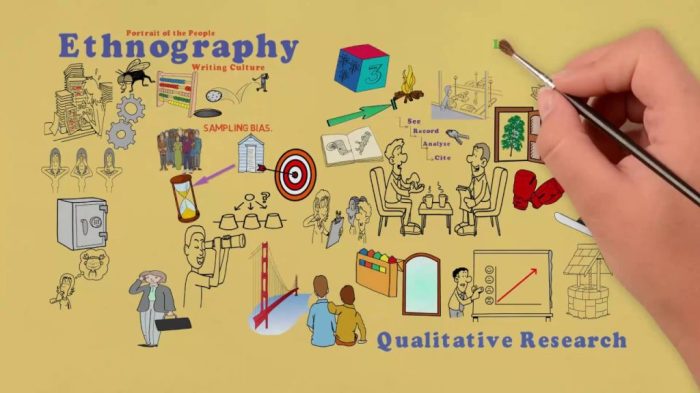
Ethnographic research methods set the stage for this enthralling narrative, offering readers a glimpse into a story that is rich in detail and brimming with originality from the outset.
These methods focus on understanding human behavior and cultures through immersive observation and interaction. By exploring diverse communities and contexts, ethnography provides invaluable insights that help researchers grasp the intricacies of social dynamics, making it a powerful tool in both academic and applied research fields.
Overview of Ethnographic Research Methods
Ethnographic research methods are a cornerstone of social science research, providing deep insights into cultural practices, beliefs, and social interactions. These methods are designed to understand communities from an insider’s perspective, allowing researchers to capture the complexities of human behavior in its natural context. This approach emphasizes the importance of immersive observation and engagement with participants, making it distinct from other research methodologies.The key principles of ethnographic research include cultural immersion, participant observation, and contextual understanding.
Ethnographers typically spend extended periods within the community they study, allowing them to gather data through direct interaction and observation. This immersive approach enables researchers to gain a nuanced understanding of social dynamics, rituals, and everyday practices, which can often be lost in more detached forms of research. Furthermore, ethnographic studies prioritize the voices and perspectives of the participants, allowing for a more authentic representation of their experiences.
Types of Ethnographic Research Approaches
There are several distinct approaches within ethnographic research, each tailored to different research questions and contexts. Understanding these approaches is essential for selecting the most suitable method for a given study.
- Traditional Ethnography: This approach involves long-term fieldwork, where researchers immerse themselves fully in the community. They may live among participants, participate in daily activities, and build relationships over time to gather rich, qualitative data.
- Autoethnography: This method combines personal experiences with cultural analysis. Researchers reflect on their own experiences as part of the study, offering insights into how their identities influence their understanding of the culture being studied.
- Visual Ethnography: This approach utilizes visual methods, such as photography or video, to capture cultural practices and social interactions. It emphasizes the role of visual media in documenting and analyzing cultural phenomena.
- Digital Ethnography: With the rise of online communities, this approach focuses on studying digital interactions and online cultures. Researchers analyze social media platforms, blogs, and virtual spaces to understand contemporary social dynamics.
Each of these approaches serves different research objectives, whether the aim is to understand a specific cultural practice, analyze the impact of digital spaces, or reflect on personal cultural experiences.
Significance of Cultural Immersion
Cultural immersion is a fundamental component of ethnographic research, as it allows researchers to engage deeply with the community they study. This approach fosters a more comprehensive understanding of social norms, values, and practices that shape individuals’ lives.Through immersion, researchers can observe interactions in real-time, noting subtle nuances that may not be evident through surveys or interviews. This depth of understanding can lead to richer, more nuanced findings.
Immersive experiences also build trust between the researcher and participants, facilitating open communication and a more authentic exchange of perspectives.
“Cultural immersion is not just observing; it’s about experiencing the culture firsthand.”
For example, anthropologists studying a remote tribe may live with the community for months, participating in rituals and daily life. This direct engagement reveals insights into their belief systems, social hierarchies, and conflict resolution practices that would be difficult to capture through detached observation. Ethnographers often find that the relationships built through immersion yield invaluable data that enrich their research findings significantly.
Techniques and Tools for Ethnographic Research

Ethnographic research employs a variety of techniques and tools aimed at gathering in-depth insights into cultures, behaviors, and experiences. Understanding these methods is crucial for researchers to effectively engage with their subjects and collect meaningful data. The right combination of techniques and tools can significantly enhance the quality and depth of the research conducted.
Data Collection Techniques in Ethnographic Research
Ethnographic research relies on diverse data collection techniques that enable researchers to immerse themselves in the lived experiences of their subjects. The primary methods include:
- Participant Observation: This technique involves the researcher engaging actively in the daily life of the subjects, allowing for an in-depth understanding of their practices and behaviors. For instance, a researcher studying a remote community may live among them for several months to gain insights into their social structures.
- In-depth Interviews: Conducting one-on-one interviews helps researchers gather personal narratives and perspectives from participants. These interviews are often semi-structured, allowing for flexibility in exploring topics that may emerge during the conversation.
- Focus Groups: Group discussions facilitate the exploration of shared experiences and collective opinions among participants. This technique is beneficial for understanding social norms and group dynamics.
- Field Notes: Researchers document observations, conversations, and reflections throughout their study. These notes serve as a rich source of qualitative data, capturing nuances that may not be evident in formal interviews.
Tools and Technologies Enhancing Ethnographic Research
The integration of modern tools and technologies can greatly enhance the ethnographic research process. These tools assist in data collection, analysis, and presentation, making the research more efficient and comprehensive.
- Audio and Video Recorders: These devices enable researchers to capture interviews and observations accurately, allowing for detailed analysis of verbal and non-verbal communication.
- Transcription Software: Tools such as Otter.ai or Rev can help in transcribing interviews quickly, enabling researchers to focus on analysis rather than manual transcription.
- Data Analysis Software: Programs like NVivo or Atlas.ti facilitate the organization and analysis of qualitative data, making it easier to identify themes and patterns in the collected information.
- Mobile Research Applications: Applications designed for fieldwork, such as Evernote or Fieldnotes, provide researchers with a platform to capture insights, photos, and audio recordings directly from the field.
Ethical Considerations in Ethnographic Research
Ethical considerations are paramount in ethnographic research, where the relationship between the researcher and participants can significantly impact the integrity of the study. Researchers must navigate these ethical dimensions carefully.
- Informed Consent: Prior to participating, individuals must be fully informed about the research purpose, procedures, and potential risks. Consent should be obtained voluntarily without coercion.
- Confidentiality: Protecting the identities and personal information of participants is essential. Researchers should anonymize data and ensure that sensitive information is handled securely.
- Reciprocity: Researchers should consider how their work benefits the community they study. Providing feedback to participants or contributing positively to the community can help build trust.
- Reflexivity: Researchers must remain aware of their biases and the impact of their presence on the research context. Continuous reflection on their role helps maintain ethical integrity.
“The ethics of ethnographic research lie in maintaining respect for the people being studied, ensuring that their voices are authentically represented.”
Integration with Market Research and Other Fields

Ethnographic research methods are increasingly being integrated into market research, public relations, and other fields, providing deeper insights into consumer behavior and social dynamics. This integration enhances the ability of organizations to connect with their target audiences by understanding their needs, motivations, and cultural contexts.Ethnography offers qualitative insights that can complement quantitative data typically gathered in market research. By observing consumers in their natural environments, ethnographers can uncover nuances in behavior that surveys and focus groups might miss.
This holistic approach allows market researchers to formulate strategies that resonate on a profound level with consumers.
Integration with Market Research Practices
The integration of ethnographic methods into market research practices can significantly enhance the understanding of consumer behavior. By blending qualitative insights with quantitative data, researchers can create a more comprehensive view of the market landscape. The following points highlight how this integration can be beneficial:
- In-depth Contextual Understanding: Ethnographic methods provide a nuanced understanding of cultural contexts that shape consumer choices, leading to well-informed product development.
- Identification of Emotional Drivers: Ethnographic research reveals the emotional and psychological drivers behind consumer behavior, which can inform marketing strategies that connect on a deeper level.
- Real-time Feedback: Observational methods allow researchers to gather real-time insights, enabling quicker adjustments to marketing campaigns based on consumer interactions.
- Enhanced Segmentation: Understanding diverse consumer behaviors through ethnography allows for more precise market segmentation, tailoring strategies to specific groups.
Relevance of Ethnography in Public Relations Strategies
Ethnographic research plays a pivotal role in shaping public relations strategies. Through a deep understanding of audience perspectives, organizations can craft communication that resonates effectively. The relevance of ethnography in this realm includes:
- Tailored Messaging: By understanding the cultural and social contexts of target audiences, PR campaigns can deliver messages that are more likely to engage and resonate.
- Informed Crisis Management: Ethnographic insights can guide organizations in anticipating public reactions and preparing responses that address concerns effectively.
- Building Community Relations: Ethnography facilitates a genuine understanding of community needs, fostering stronger relationships between organizations and the publics they serve.
Comparative Analysis of Ethnographic Research and Telemarketing Approaches
When comparing ethnographic research methods with telemarketing approaches, significant differences emerge in terms of engagement and insight generation. In telemarketing, the focus is primarily on direct outreach and sales through scripted interactions. This method often lacks the depth of engagement that ethnographic research offers. Here are key distinctions:
- Interaction Depth: Ethnographic research fosters deep, qualitative interactions, whereas telemarketing relies on brief, transactional calls.
- Consumer Centricity: Ethnography emphasizes understanding consumer behavior in context, while telemarketing may focus more on immediate sales goals.
- Data Richness: Ethnographic insights provide rich, contextual data that informs long-term strategies, unlike telemarketing which often produces limited quantitative data.
- Long-term Relationship Building: Ethnography aims to build long-term relationships through understanding, while telemarketing tends to prioritize short-term conversion rates.
Final Review
In summary, ethnographic research methods not only reveal the depths of cultural practices but also bridge the gap between theoretical knowledge and real-world application. As we navigate the complexities of human behavior, these methods continue to play a pivotal role in enhancing our understanding of the world around us.
Query Resolution
What is the main goal of ethnographic research?
The main goal is to understand people’s experiences and behaviors within their cultural context through immersive observation and participation.
How long does ethnographic research typically take?
The duration can vary widely depending on the study, ranging from a few weeks to several months or even years, as it requires deep engagement with the community.
What are some common challenges faced in ethnographic research?
Challenges include gaining trust from participants, dealing with ethical concerns, and managing researcher bias during data collection and analysis.
Can ethnographic research methods be used in digital settings?
Yes, researchers can adapt ethnographic methods to online environments, studying digital communities and interactions through virtual observation and engagement.
What skills are important for conducting ethnographic research?
Key skills include strong observational abilities, effective communication, cultural sensitivity, and analytical thinking to interpret complex social phenomena.





